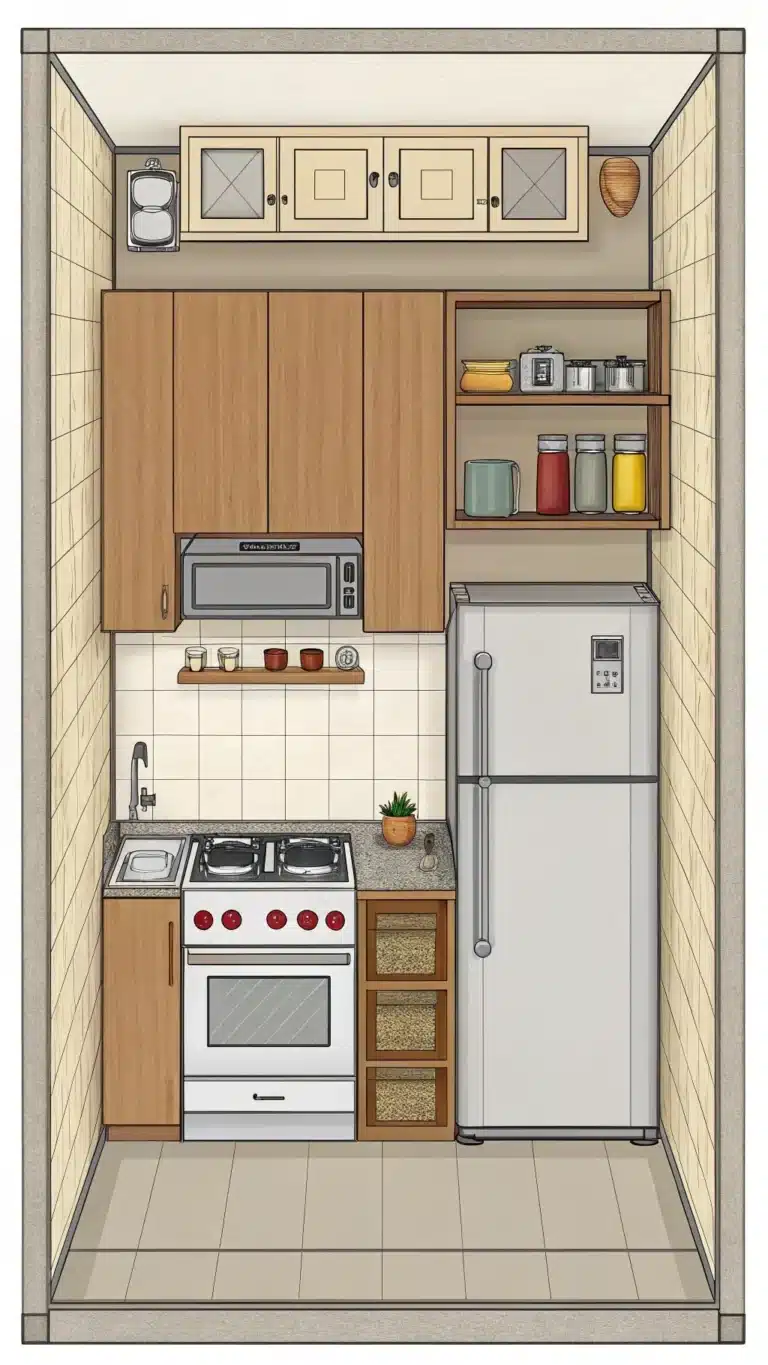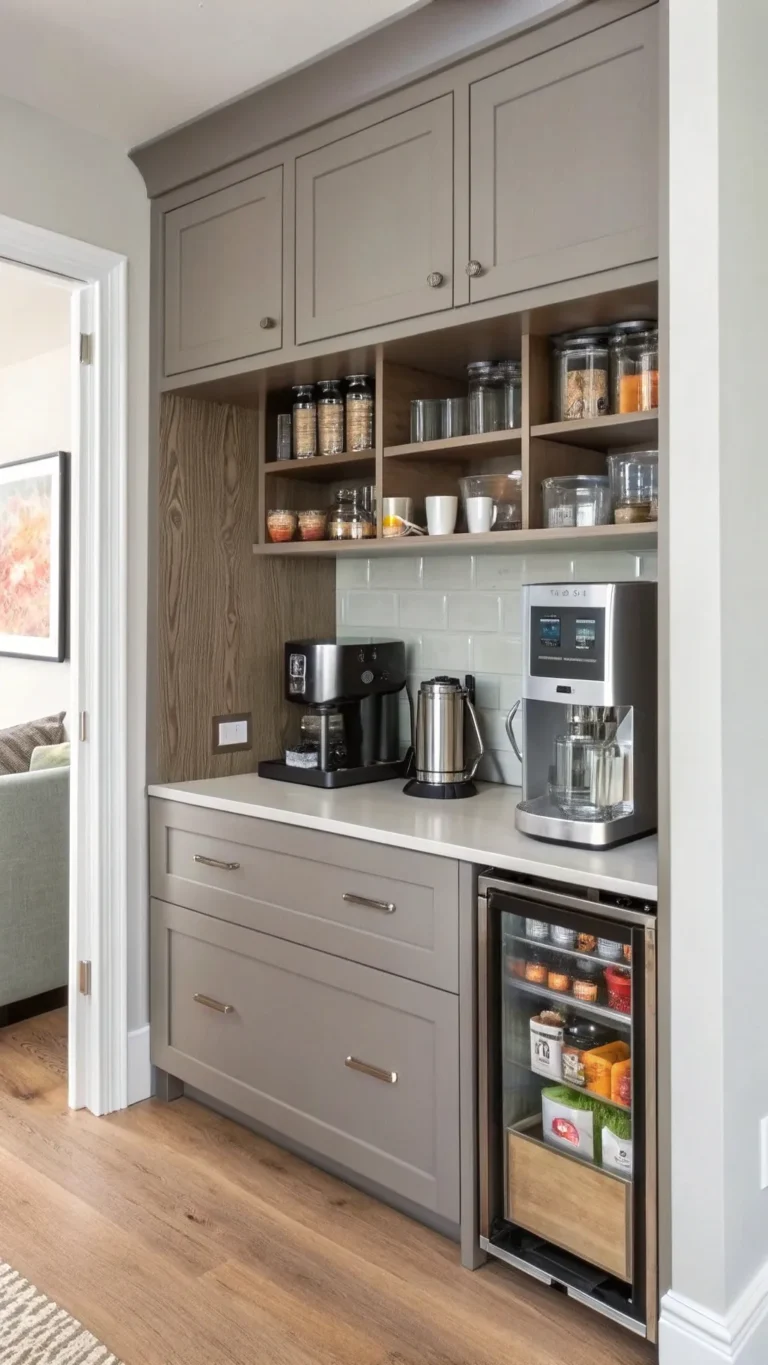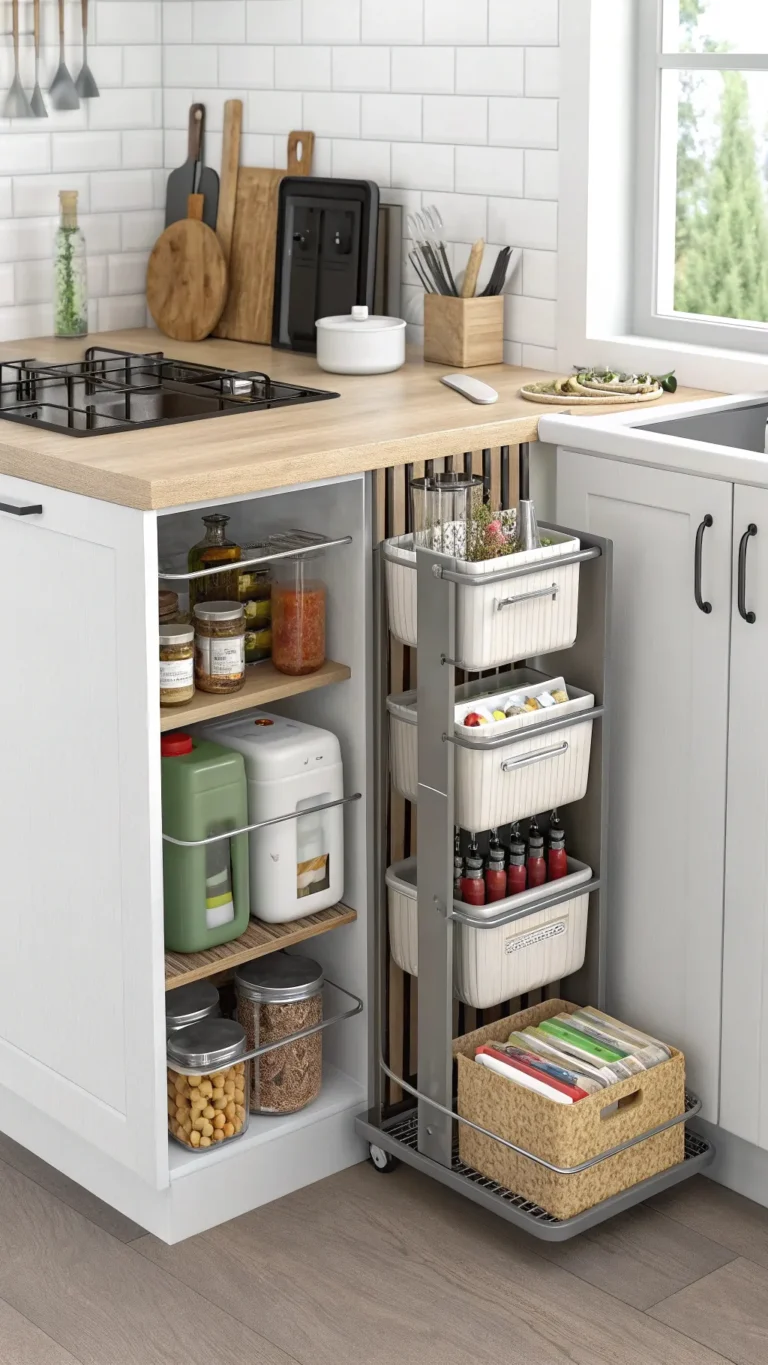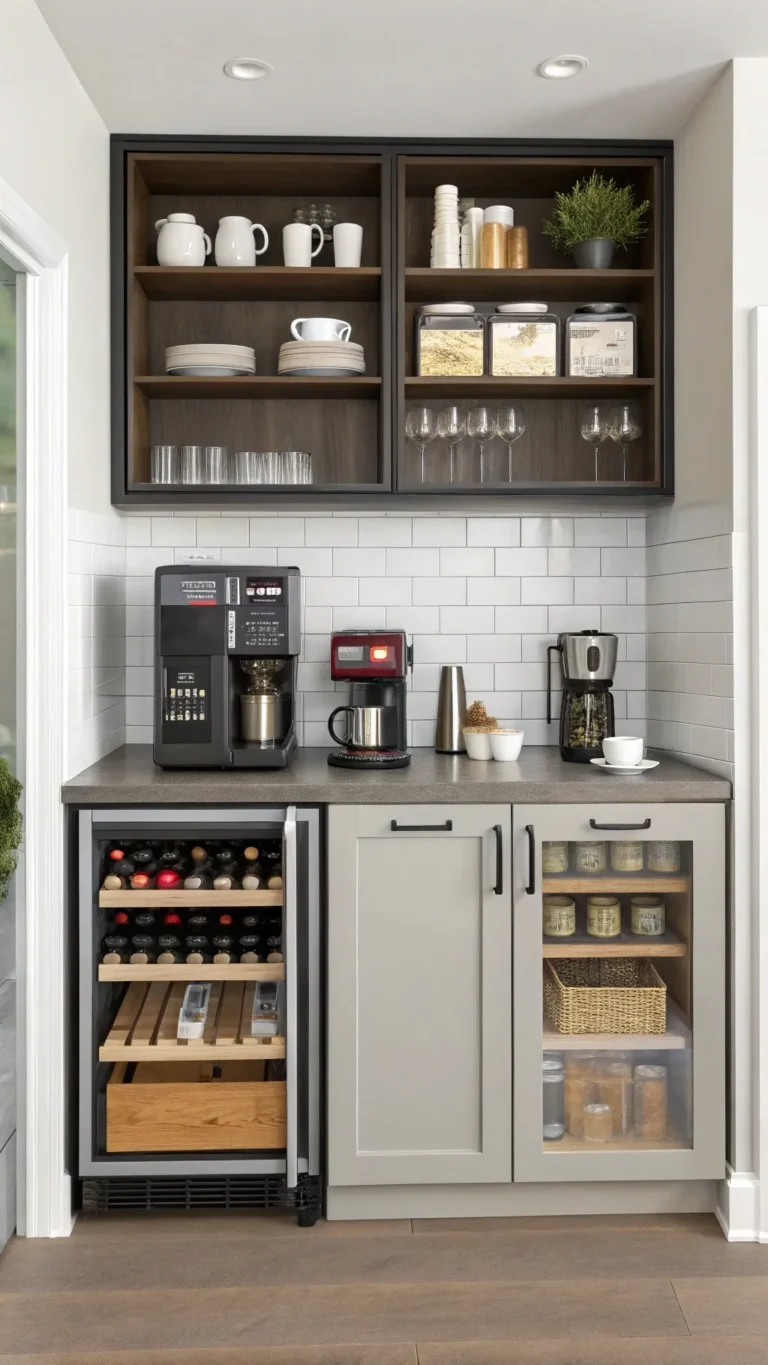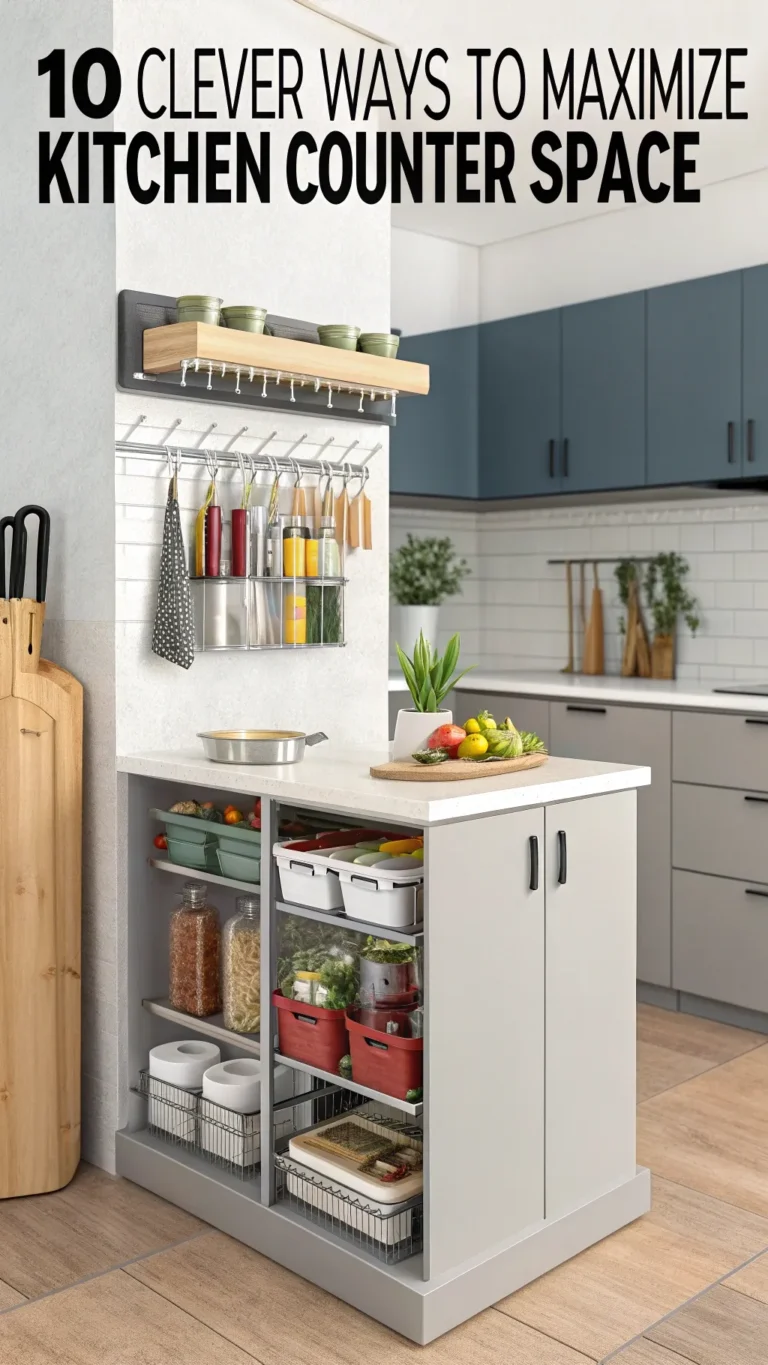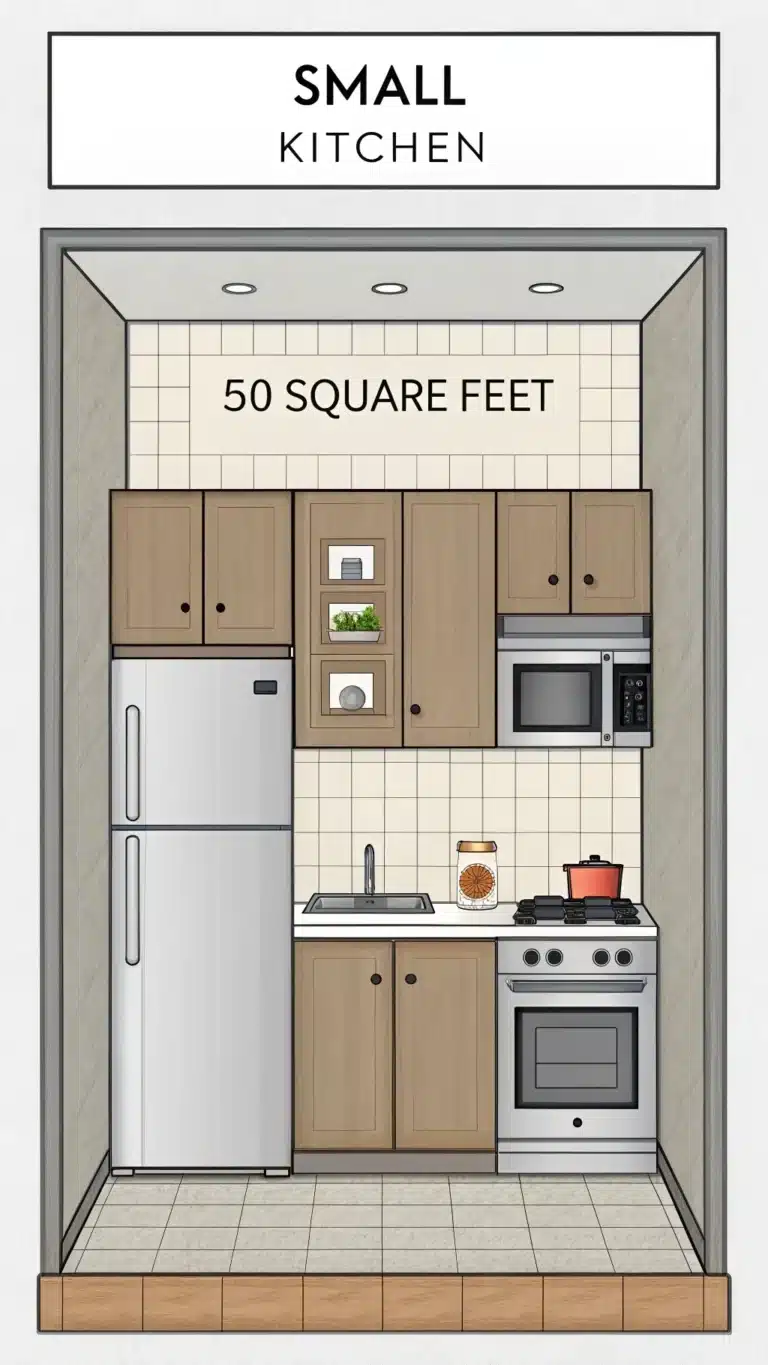Introduction
Small kitchens often bring big headaches. Limited counters, shallow cabinets, and crowded shelves make cooking feel hard. Storing food? That becomes a puzzle few can solve easily. Clutter piles up fast. Boxes spill out. Finding that jar of pasta sauce feels like a treasure hunt.
Yet, small kitchen food storage does not have to be stressful. Thoughtful ideas and practical tricks can create order. Take control of the chaos. Use every inch smartly. Imagine a kitchen where everything has its place. No mess. No wasted food. Cooking becomes a joy again.
This guide shares clever strategies for small kitchen food storage. From vertical tricks to hidden spots, smart containers to modern trends. Whether you rent or own, love DIY or prefer simple fixes, these ideas help. Read on to transform your tiny space into an efficient, organized kitchen.
Section 1: Understanding Your Space & Laying the Groundwork
Beyond the Cabinets: Assessing Your Small Kitchen for Maximum Storage Potential
Every storage plan begins with clear eyes. Not just looking at cupboards, but surveying all kitchen corners. Before buying bins or shelves, map your space well.
Declutter First. Clearing clutter feels like a fresh start. Remove expired food. Donate unused appliances. Sort through pantry items. Toss anything stale or broken. This frees space and calms your mind.
Start by emptying one cabinet or shelf at a time. Check expiration dates on cans, jars, and boxes. A 2023 study shows households waste 30% of stored food due to clutter and spoilage. Avoid this by cautious sorting.
Map Kitchen Zones. Think in areas: prep, cooking, cleaning, and storage. Keep spices near the stove for easy reach. Baking supplies stay near prep counters. Overlapping zones happen in small kitchens; aim for a flexible approach.
Look Beyond Cabinets. Walls, backs of doors, under sinks, and even toe kicks offer storage spots often missed. Measuring these areas reveals hidden potential.
Measure Carefully. Use a tape measure to check cabinet heights, depths, and wall widths. A small kitchen leaves no room for mismatched containers or racks. Mark measurements on paper or with painter’s tape—a simple guide for buying storage.
Tip: Try a mini decluttering project today. Clear just one shelf fully. Repeat weekly. This steady approach simplifies the task.
[Internal Link: How to Declutter Your Kitchen in a Weekend]
Section 2: Conquering Vertical Space – The Small Kitchen’s Best Friend
Look Up! Leveraging Vertical Storage for Small Kitchen Food Storage
Floor space often runs out first. The ceiling and walls remain free. Vertical storage uses this space brilliantly.
Wall-Mounted Shelves come in many types. Open floating shelves keep food visible and accessible. They encourage neatness as mess shows quickly. Closed wall cabinets hide clutter but need precise installation.
Group similar food containers on shelves for a nice display. Glass jars with labels create order and charm. Match container sizes for stacking ease.
Pot Racks and Hanging Systems also hold food. Hanging baskets can contain onions, garlic, or fruit. Use S-hooks for bags of snacks or herbs. Ceiling mount racks free wall space, while wall-mounted racks offer easy reach.
Over-the-Door Organizers add storage on pantry or kitchen doors. Wire racks hold spice jars, snack packets, or foil rolls. Canvas pouches help organize small packets and wraps. These systems make use of unused door space.
Space Above Cabinets usually collects dust. Place decorative bins or baskets here for bulk dry goods. Large pasta boxes or paper towels fit well. A neat container keeps the area tidy and easy to clean.
Vertical Spice and Jar Storage saves shelf room. Magnetic spice racks attach inside cabinet doors. Tiered risers stack jars inside cabinets or on countertops for easy access.
Tip: Measure door thickness before buying over-door racks. Install sturdy shelves securely to hold weight safely.
[Actionable Tips: Basic shelf installation guide, S-hook uses, picking over-door organizers]
Section 3: Mastering Cabinet & Drawer Organization
Unlock Hidden Potential: Smart Cabinet & Drawer Organization for Small Kitchen Food Storage
Cabinets and drawers store most kitchen food. Using their space well avoids overcrowding.
Cabinet Solutions. Deep cabinets hide items. Pull-out shelves reveal contents. Lazy susans spin items in corners. Tiered risers stack cans and jars. Vertical dividers hold lids and pans upright.
Mount hooks or small racks on cabinet doors for spice packets or measuring spoons. Keep heavy bulk items low for safety.
Drawers Explained. Use dividers to separate spices, utensils, and wraps. Adjustable dividers adapt to different drawer sizes. Group items by function. This stops scrambling and saves time.
Stackable Containers Transform Storage. Uniform containers stack neatly. Glass ones last long and look clean. BPA-free plastic options are lighter. Bamboo or metal containers offer eco-friendly style.
Store dry goods like rice, flour, or cereal in airtight containers. Snacks stay fresh longer. Uniform shapes save space. Labels prevent confusion.
Pantry Ideas. Even without a dedicated pantry, organize cabinets with bins. Sort foods into categories such as baking or snacks. Use FIFO (First In, First Out) to rotate stock. Label bins for quick identification.
Tip: Choose containers with wide openings for easy scooping.
[Internal Links: Review of Food Storage Container Sets; Best Kitchen Organization Tools & Gadgets]
Section 4: Utilizing Countertops & Appliance-Adjacent Spaces
Smart Strategies for Limited Counter Space & Appliance Storage in Small Kitchen Food Storage
Counter space remains precious. Hold only essentials here.
Countertop Storage. Keep ripening fruit or everyday oil bottles on easy-reach stands. Tiered fruit bowls maximize vertical space on counters. Choose containers matching your kitchen colors to reduce visual clutter.
Avoid stacking too many items on counters to keep workspace clear.
Refrigerator & Freezer. Organize every inch inside. Use clear bins to group leftovers or snacks. Stackable containers prevent spills. Door shelves suit sauces and drinks. Crisper drawers separate fruits and vegetables.
Space Near Appliances. Oven interiors can hold pots or trays when not in use, but remove before cooking for safety. Use space above the fridge for large food items in baskets. Attach magnetic spice racks on fridge sides for quick access.
Under-Sink Storage. Though not for food, organizing cleaning supplies here frees cabinet space elsewhere. Use pull-out bins and trays to keep the area neat.
Tip: Regularly remove expired items from fridge. This prevents odor and wasted space.
Section 5: Creative & Often Overlooked Storage Spots
Think Outside the Box: Unconventional Spots for Small Kitchen Food Storage
Tiny kitchens need creativity. Some spots surprise with storage options.
Toe Kick Drawers slide out low near floor level. Great for flat items like cookie sheets or cutting boards. Freed drawer space helps store food items better.
Side of Cabinets or Appliances. Narrow pull-out pantries fit next to fridges or cabinets. They keep cans, spices, or snacks in reach but out of sight. Magnetic strips attached to cabinet sides hold metal lids or small jars.
Kitchen Carts or Islands. Add a rolling cart for extra storage and counter space. Store produce, ingredients, or small appliances. Move it as needed.
Corners Matter. Odd corners get lost. Pull-out kidney shelves or corner lazy susans maximize these spaces. Corner shelves on counters hold jars or baskets.
Adjacent Wall Space. Small, narrow pantries or shelves along a nearby hall or dining room wall increase storage. Keep these stocked with less-used dry goods.
Tip: Measure narrow spaces before buying pull-outs. DIY solutions often fit better.
Section 6: Smart Storage Solutions & 2025 Trends
Organizing Smart: Modern Solutions & 2025 Trends in Small Kitchen Food Storage
New trends bring fresh ideas for small kitchens.
Modular and Customizable Systems adapt to spaces of all shapes. Brands like Elfa or Container Store offer adjustable shelves and bins. Flexibility helps because every kitchen differs.
Sustainable Storage Options rise in popularity. Glass, bamboo, stainless steel, and recycled plastics are eco-friendly. They look nice and last longer, reducing waste.
Smart Organization Principles emphasize zones and decanting dry goods into uniform containers. Stack vertically with risers. Label bins clearly to speed hunting for ingredients.
Technology Helps, Too. Simple apps track pantry inventory. They remind you when food nears expiry. This lowers waste and prevents overbuying.
Multi-Functional Furniture grows in use. Over-sink cutting boards save space. Nesting bowls and collapsible containers fit small kitchens perfectly.
Tip: Start modular systems small. Expand with your needs over time.
[Internal Links: Review Top Food Storage Container Sets; Best Kitchen Organization Tools & Gadgets]
FAQs: Your Small Kitchen Food Storage Questions Answered
Q1: How do I organize a small kitchen pantry (or a cabinet acting as one)?
Start with decluttering. Use vertical risers. Sort items into bins by type. Store dry goods in uniform containers. Label bins clearly for quick access.
Q2: What are the best containers for small kitchen food storage?
Choose airtight, stackable containers. Glass resists smells and stains. BPA-free plastic is light and affordable. Bamboo and metal containers offer sustainable options. Uniform shapes save space.
Q3: How can I create more storage in a tiny kitchen without remodeling?
Use wall shelves, over-door racks, magnetic strips, and kitchen carts. Organize cabinets with pull-out shelves and dividers. Declutter regularly. Look over cabinets and door spaces.
Q4: What’s the best way to store fruits and vegetables in a small kitchen?
Use fridge crisper drawers properly. Keep onions, potatoes, bananas, and tomatoes in open baskets or breathable bags outside the fridge. Air circulation prevents spoiling.
Q5: How can I keep my small kitchen food storage organized long-term?
Maintain zones and labeling systems. Tidy weekly. Put items back after use. Perform mini declutters every few months. Follow FIFO: use older items first.
Conclusion
Transforming small kitchen food storage takes little steps. Assess your space. Clear clutter. Use vertical walls and doors. Organize cabinets with smart containers. Find creative spots often ignored. Embrace modern trends and sustainable choices.
A well-stored kitchen feels larger and calmer. Cooking flows smoothly. Food stays fresh longer. Stress fades when everything is in place.
Start with one drawer or shelf today. See the difference. Share your own small kitchen storage hacks to help others. Together, we create kitchens that work best for our homes.
This guide gives every tool needed. Take action. Make your small kitchen neat and easy to use. Organization lies within reach.
End of article.

